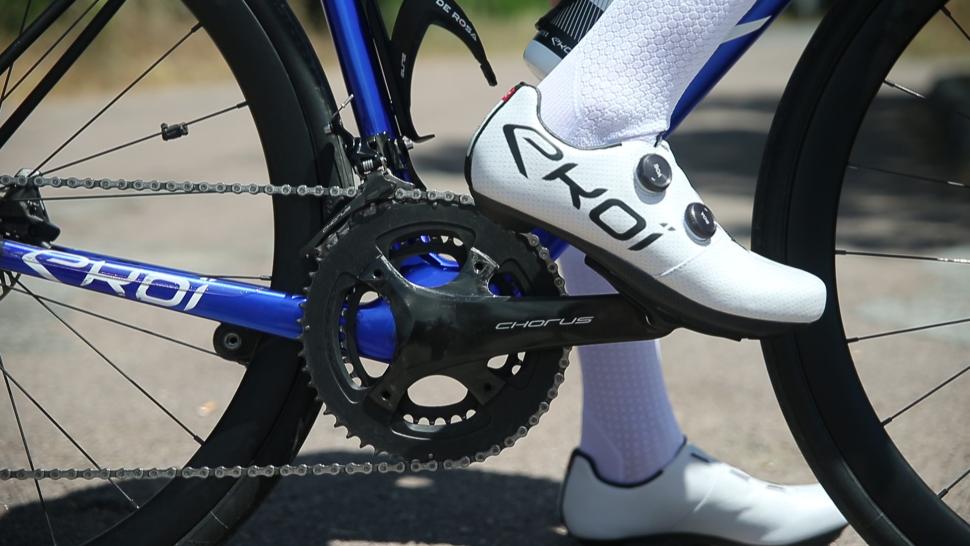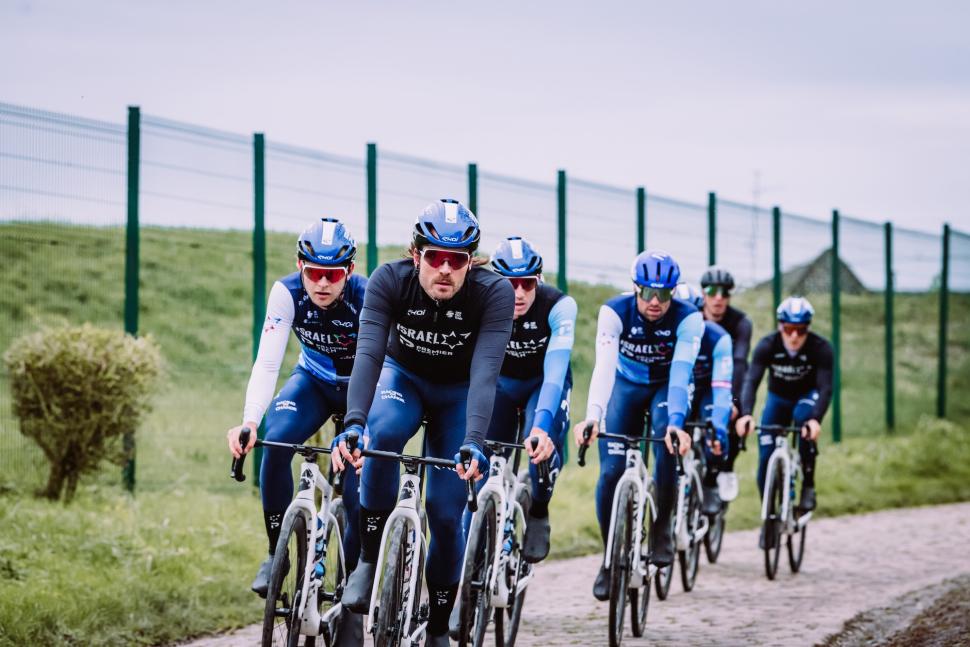- News
- Reviews
- Bikes
- Components
- Bar tape & grips
- Bottom brackets
- Brake & gear cables
- Brake & STI levers
- Brake pads & spares
- Brakes
- Cassettes & freewheels
- Chains
- Chainsets & chainrings
- Derailleurs - front
- Derailleurs - rear
- Forks
- Gear levers & shifters
- Groupsets
- Handlebars & extensions
- Headsets
- Hubs
- Inner tubes
- Pedals
- Quick releases & skewers
- Saddles
- Seatposts
- Stems
- Wheels
- Tyres
- Tubeless valves
- Accessories
- Accessories - misc
- Computer mounts
- Bags
- Bar ends
- Bike bags & cases
- Bottle cages
- Bottles
- Cameras
- Car racks
- Child seats
- Computers
- Glasses
- GPS units
- Helmets
- Lights - front
- Lights - rear
- Lights - sets
- Locks
- Mirrors
- Mudguards
- Racks
- Pumps & CO2 inflators
- Puncture kits
- Reflectives
- Smart watches
- Stands and racks
- Trailers
- Clothing
- Health, fitness and nutrition
- Tools and workshop
- Miscellaneous
- Buyers Guides
- Features
- Forum
- Recommends
- Podcast
Inside Ekoi — the story behind the most popular kit in the Tour de France peloton

This article includes paid promotion on behalf of Ekoi
As part of our brand insider series, we give you behind-the-scenes access to the cycling brands that you know and love. In this edition, we're in the South of France to explore a company that isn't afraid to do things differently and often flies under the radar in the UK. This is Ekoi HQ, where there's some seriously interesting cycling tech to discover.
Who are Ekoi?
Founded in Roubaix in 2001, Ekoi relocated to Fréjus in the South of France in 2008, the same year they launched their first website.
From that moment on, the wins started to accumulate. In 2009, an Ekoi helmet was worn to a Tour de France stage victory. In 2011, they equipped Phillippe Gilbert, the world number one at the time, with revolutionary recovery clothing. Since then, Ekoi have equipped multiple WorldTour teams, secured a Vuelta win, won the IronMan World Championships, and their products are now a common sight in the pro peloton.
In fact, this year Ekoi provides Israel Premier Tech, Arkéa B&B Hotels, Lotto Destny and Cofidis with a combination of clothing, helmets and sunglasses. Not to mention that the likes of Carlos Rodriguez, Guillaume Martin and Thymen Arensmen all choose Ekoi shoes.
Ekoi according to their founder
So, why do so many pro teams and riders choose Ekoi, and how did the French newcomer become quite so prevalent in the peloton? To find out, there's no one better to ask than the founder and president of Ekoi, Jean Christophe Rattel.
Rattel says: "Ekoi is a specialist of full equipment for road, gravel, triathlon and for MTB. But our goal is to make full equipment in all segments. Our main product is our clothing but we really specialise in helmets and my goal is to have innovative products in all categories and in all disciplines if it's possible."
So, why did Ekoi choose to work with soo many pros? Ekoi currently sponsors eight teams, four of which are at this year's Tour de France. Rattel has numerous connections in the sport and explains that there is a unique story for each team they work with. He notes that the company often responds to athletes' requests to address specific issues with garments, creating products to meet their needs, adding, "It's not really strategic [when choosing teams], it's a question of friends and passion also."
Working with pro teams also helps Ekoi to develop their products. Rattel says, "I know that if we make a sponsorship, we need to give the racers the best products. If not, it's very bad advertising and it could be a disaster for a brand."
He adds, "It's interesting to have their feedback and the racers come very often to the company and they are at home here. I remember Nairo Quintana when he lived in Monaco, he came three to four times per year to discuss about the clothes, the stitching of the clothes and some details which for us was very important because we want to give them the best and we can improve our products."
Is Ekoi just for the pros?
"No, of course not. The pros are very expensive for us. For example, for the time trial helmets we spend a lot of money and we sell very few quantities but the expertise of the pros is very useful for our whole range."
Ratte explains that Ekoi categorises their range into three distinct categories. The START range targets riders who cycle one to two times a week, PERFORMANCE is tailored for more frequent riders, and the RACING category offers gear identical to what the pros wear.
So, where is Ekoi going in the future?
Ekoi isn't scared to do things a bit differently. For example, the E-Lens glasses and the PW8 pedals that we recently made a video on.
Rattel emphasises, "For me, in the future, we will make a difference in bringing new innovative products to the market. If there is only marketing innovation, it does not work because in each country we have a lot of competitors and if we want to be competitive we need to bring innovative products."
He continues, "Now, we have the capacity to invest to create innovative products because for example, for the PW8 pedals, we are on that project for three years now. I spent a lot of money. It's not a question of turnover, it's not a question of business, it's the question of bringing to the market something different and something to make better. It costs a lot but it brings a lot of pleasure because now we have the possibility to do it and it's a pleasure to work in that way."
Ekoi has established a strong presence across much of Europe, however, the brand remains less recognised in the UK. Addressing what unique offerings Ekoi could provide to riders in the UK, Rattel states, "I would like to bring custom products to that market to make products different. I think we will succeed step by step. We have a lot of possibilities for custom products and I think we can bring something different."
Ekoi's custom products extend beyond professional cyclists. On their website, you'll discover a variety of customisation options, from personalised helmet finishes to a range of coloured frames for glasses.
When asked about Ekoi's future direction, Rattel reflects, "It's difficult to answer that question but I think we continue to grow step by step to try to make different products, to work on innovation and we will see."
He emphasises, "It's not a question of business, it's not a question of turnover, because more turnover means more problems, more stock, more difficulties. We are focused on the products and also to understand our customers, to deliver very fast, to deliver well and to continue to innovate."
Innovating
Innovation is a big part of what Ekoi do, and you don’t have to look far to see some really unique products. To delve deeper into Ekoi's innovation process, we spoke to Luca Viano, the helmets and glasses product manager at Ekoi, who talked us through the process of designing products from scratch, entirely in-house.
"The very first idea comes from either a need in the market that we find, a specific request from a team, or as it happened lately, a change of rules. For example, within the UCI", he says.
Designing innovative products involves a meticulous process driven by data and extensive testing. As Viano explained, "We test everything we can find in the market. Sometimes products are not yet available so we can't test them but we rebuild them in 3D based on the pictures and images that we have, try to also stimulate what's going on with the testing and then we start building in 3D."
Once the 3D models are created, the next step involves comparing the simulations with everything they have from other brands and previous designs. For instance, Viano mentioned that they went through 32 different models of the new TT helmet currently used at the Tour de France. Once the best design has been found in the simulation, the engineering phase can begin.
The racing environment necessitates rapid innovation, especially when new materials become available. "Doing things in the fastest time is not for the community, it's for racing. If things change in racing, like a new material comes out we need to have it right away. If it waits two years, as a standard development time frame is 18 to 24 months, we wouldn't be leading anymore in the racing environment. So, we need to focus there."
Ultimately, Ekoi strives to balance innovation with accessibility. Viano says, "Ekoi is a brand for everybody but it's a racing brand. So, we always aspire to be there and it's always nice to guarantee the same exact product to everybody.
"It's a little bit of a Formula One approach. So you maybe do two or three approaches in the same time which is of course, not cost-effective, but it's time-effective, performance-effective."
With the Tour de France experiencing record-breaking temperatures, we were keen to find out more about Outlast technology, which was originally developed for NASA. It is a system of thermoregulation which is utilised in Ekoi's jerseys and the brand claim it can reduce your temperature by 1-2°C while riding. To learn more about Outlast technology, visit Ekoi's website.
Emily is our track and road racing specialist, having represented Great Britain at the World and European Track Championships. With a National Title up her sleeve, Emily has just completed her Master’s in Sports Psychology at Loughborough University where she raced for Elite Development Team, Loughborough Lightning.
Emily is our go-to for all things training and when not riding or racing bikes, you can find her online shopping or booking flights…the rest of the office is now considering painting their nails to see if that’s the secret to going fast…










Drivers react to Brinkworth Road Lidl works causing delays...
+1 for diesel; is the corner on a bus route? They're the worst culprits though there are plenty of others. Often impossible to see, one of my...
Absolutely not. I work for a cycling company and regularly travel to Europe with a bike, I always get stopped to check if I had products to sell in...
Woman arrested after car flips onto roof in Oxford crash...
I am, but not that much!
Nobody "deserves" to be spat on, be they riders, fans or anyone else. Saying that riders shouldn't spit on spectators isn't demanding they act like...
Q36.5 Gregarius Essential Bib Knickers fit the bill: 3/4 length bib tights for warm weather.
Jolly good. Only it hasn't been and it is still a public bridleway. Feel free to look it up.
"...it feels more like a £100+ jersey". It's almost as if cycling apparel is over priced.
I've had a few Lezyne bits and bobs over the years and while it's true I've never bothered to return anything under warranty, I've had a couple of...